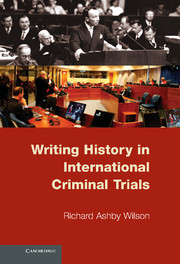Book contents
- Frontmatter
- Contents
- Epigraph
- Preface and Acknowledgments
- Figures and Tables
- Glossary
- 1 Assessing Court Histories of Mass Crimes
- 2 What Does International Actually Mean for International Criminal Trials?
- 3 Contrasting Evidence: International and Common Law Approaches to Expert Testimony
- 4 Does History Have Any Legal Relevance in International Criminal Trials?
- 5 From Monumental History to Microhistories
- 6 Exoneration and Mitigation in Defense Histories
- 7 Misjudging Rwandan Society and History at the International Criminal Tribunal for Rwanda
- 8 Permanent Justice: The International Criminal Court
- 9 Conclusion: New Directions in International Criminal Trials
- Appendix: Methodology and the Survey Instrument
- Bibliography
- Index
3 - Contrasting Evidence: International and Common Law Approaches to Expert Testimony
Published online by Cambridge University Press: 05 June 2012
- Frontmatter
- Contents
- Epigraph
- Preface and Acknowledgments
- Figures and Tables
- Glossary
- 1 Assessing Court Histories of Mass Crimes
- 2 What Does International Actually Mean for International Criminal Trials?
- 3 Contrasting Evidence: International and Common Law Approaches to Expert Testimony
- 4 Does History Have Any Legal Relevance in International Criminal Trials?
- 5 From Monumental History to Microhistories
- 6 Exoneration and Mitigation in Defense Histories
- 7 Misjudging Rwandan Society and History at the International Criminal Tribunal for Rwanda
- 8 Permanent Justice: The International Criminal Court
- 9 Conclusion: New Directions in International Criminal Trials
- Appendix: Methodology and the Survey Instrument
- Bibliography
- Index
Summary
The modern European law of evidence is fairly simple and rational: the law lets most everything in and trusts the judge to separate good evidence from bad. But American legal culture tends to distrust the judge; and…the system obviously trusts the jury even less that it trusts the judge. The rules of evidence grew up as some sort of countervailing force.
– Lawrence Friedman (2006:101), A History of American LawA HISTORY OF HEARSAY
This chapter compares the rules of procedure and evidence of international criminal tribunals with those of Anglo-American courts, concentrating on the admissibility of historical evidence and expert witness testimony. In both national and international trials, experts called by the parties are the main conduit for historical evidence. The decision of judges to admit or exclude evidence in the courtroom goes to the heart of a legal system's understandings of probative value and fact, the building blocks of knowledge about an armed conflict. Although international courts are appreciably more lenient with respect to various types of evidence, including historical expert testimony, this varies according to the type of case and is most pronounced in trials of senior political leaders. Before addressing international criminal tribunals, however, it is worth reviewing conventional evidentiary practices in common law jurisdictions. A central defining feature of Anglo-American law is how it assiduously filters and evaluates evidence, and only by grasping this can one appreciate the sharp contrasts that exist with international criminal law.
- Type
- Chapter
- Information
- Writing History in International Criminal Trials , pp. 49 - 68Publisher: Cambridge University PressPrint publication year: 2011



